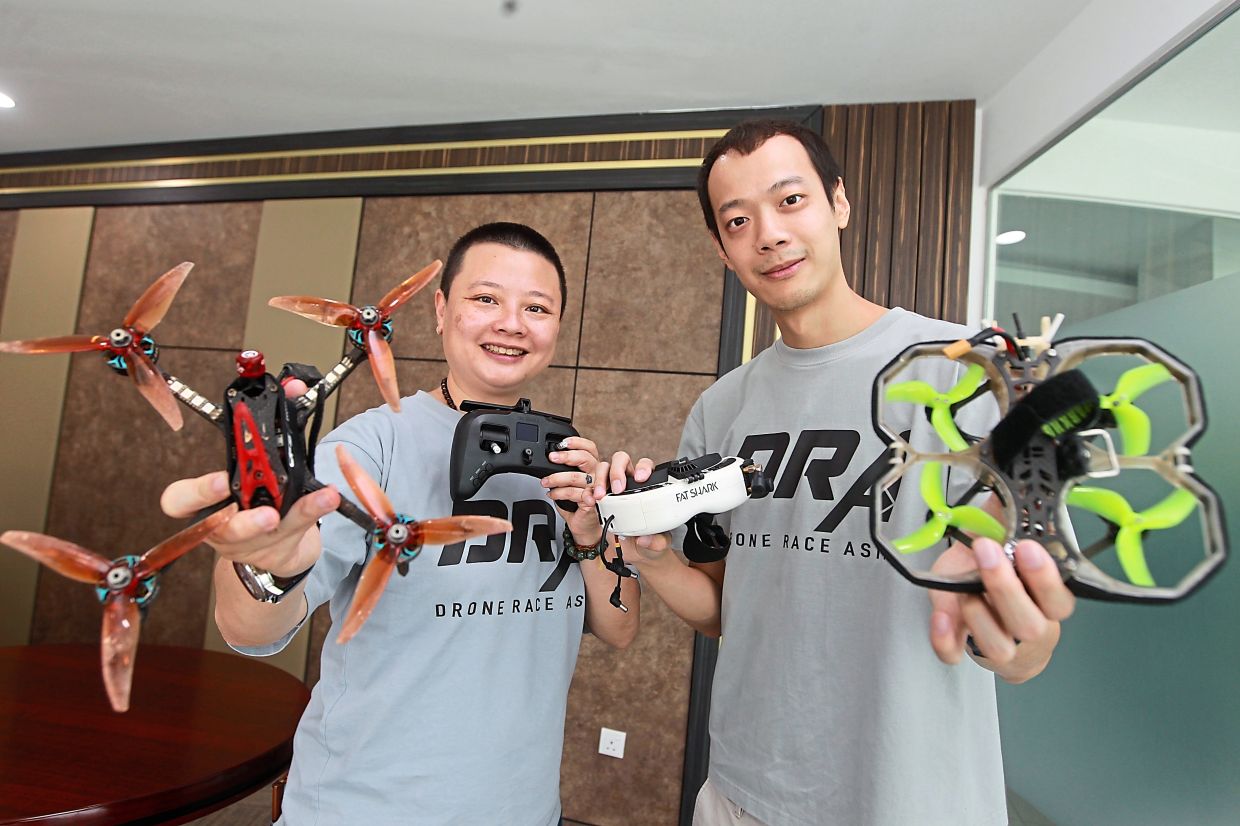WHAT comes to mind when you think of the word drone?
It could be futuristic autonomous bots delivering packages of things you ordered online right to your doorstep, or maybe those light shows put on during big celebrations like National Day and New Year’s.
In Malaysia, we’ve seen them used in agriculture, where they help cultivate and spray pesticides in paddy fields, and in disaster response, surveying the severity of the damage and searching for victims.
Drones are steadily becoming a part of our lives, but for some folks, their first thought is all about the need for speed in drone racing.
Flying frenzy
Drone Racing Association Malaysia (DRAM) president Fitri Reza says drone racing is unique as players get to seamlessly shift from the virtual realm of simulated races to the exhilarating reality of the track.
“When it comes to cars, for instance, sim racing and the real thing are separate, meaning there is no interaction between the two.
“Of course, there are exceptions where sim racers get brought into the real thing, like in the Gran Turismo movie (which is based on the true story of gamer-turned-racer Jann Mardenborough) – this is what usually happens with drone racing.
“There are separate competitions for both, but most of the time, you start off with the simulator, and it’s very similar to the real world, so the transition will be easier, which helps draw people in.
“It’s similar to virtual reality (VR) in the sense that you see everything through goggles, but I believe it’s better because it’s all real,” he says.
Traditional drones from big brands usually come with features like auto hover, along with a plethora of sensors that help with controls, but racing drones are entirely manually operated via a first-person video (FPV) feed.
The video feed, transmitted to racers’ goggles, offers pilots the drone’s perspective as they take on the daunting challenge of manually controlling the drone at speeds exceeding 100kph.
For those susceptible to motion sickness, the view they experience while wearing the goggles as the drone hurtles through the sky can lead to feelings of nausea and dizziness. It’s important to be cautious, as adapting to this experience may take some time.
For Johnson Yap, president of the Drone Racing Club (DRA), this is all part of the draw of the hobby.
“What really captured me was the feeling of immersion, like you’re actually up there flying in the air. That and the adrenaline rush from the first-person view as well,” he says.
Racing regimen
Fitri Reza emphasises that, much like any other sport, achieving mastery in drone racing requires dedicated practice and consistent training to build muscle memory.
“If I were to race now, I might not win, and I might not even be in the top 10 – after not flying for a while, you become unsteady.
“You would need to allocate a week or two to prepare for a race, spending about 20 (charges) of battery a day, which is about two to three hours of practice a day.
“That is provided you are already able to fly. If not, I would say the fastest you can be race-ready is about three months.
“We’ve had cases where newbies really put in the effort to learn on the simulator at home multiple days a week and visit actual courses to fly in person regularly.
“By the time they were three months in, they were tournament-ready,” Fitri Reza says.
Alongside the need for good reflexes is a deep pocket, as both Fitri Reza and Yap say that drone racing is an expensive hobby as racers will have to spend money on gear and components before they can get started.
There are three categories of FPV drones: tiny whoops, which are smaller drones with 65mm blades that have a protective ring around them, as well as 3in and 5in standard racing drones with exposed blades.
A basic racing drone can cost between RM1,500 and RM2,500, but for those looking for a competitive edge, the total component costs can reach up to RM10,000.
“You can buy FPV racing drones off the shelf, prebuilt and ready to use, without requiring any assembly or technical knowledge.
“But even then, pilots will still need to learn how to fix and replace certain parts – especially rotor blades – on their own, as drones will experience crashes and get damaged over time.
“Of course, there are shops that can help with this, but you’ll want to learn how to do it yourself so that you can gradually upgrade the parts.
“I practised on dummies to get the hang of things before moving on to the real thing,” Yap says.
Those who build their own drones will require some basic soldering skills to be able to add and remove components, along with some knowledge on the software side of things.
Fitri Reza says that once individuals grasp the fundamentals, they have the option to seek additional guidance from the community and explore various online resources.
Simulation software, on the other hand, is generally affordable, with the official program, The Drone Racing League Simulator, priced at RM23.50 on Steam, though a controller costing between RM100 and RM500 will be required.
The simulators feature up-to-date courses identical to those used in drone racing, including international and MultiGP leagues, providing racers with valuable opportunities for advanced practice and avoiding accidents.
“Drones aren’t like cars. Sure, they’re both manually controlled, but you can always stop your car somewhere to take a break.
“If you did that with an FPV drone, it’s going to crash, as you are the one flying it, and nothing is going to keep it floating besides you.
“It requires a high level of focus. The moment you let go, the drone falls. No one wants to spend RM2,000 on a drone to have it crash or find out after buying one that they’re not enjoying it as much as expected.
“This is why beginners are recommended to start with simulators to get a feel for the hobby and decide if they like it,” Fitri Reza says.
To help racers gain hands-on experience, DRAM says it built the country’s first public indoor drone racing course.
According to Fitri Reza, a number of schools have visited the indoor racing course to explore the idea of building their own arenas for school-level leagues.
Additionally, the public is welcome to visit, provided they contact the organisation through its Facebook page to schedule an appointment in advance.
The indoor course, made in collaboration with the Malaysian Research Accelerator for Technology and Innovation, is located at Mranti Park in Bukit Jalil.
League of their own
Choy Yuen Yee, director of Magic Beans Alchemy, which is organising the Drone Race Asia championship in December, believes that despite the accessibility issues faced by the players, anyone is capable of becoming a real contender.
“There’s no gender bias or age limit. In 2018, an 11-year-old girl from Thailand knocked out all the adults in an international league and was crowned champion.
“Two years earlier, a British teenager took home a US$250,000 cash prize in Dubai, beating over 100 participants.
“Drone racing is purely skill and passion,” she says, but adds that the main obstacle right now is a lack of awareness.
“We did our research before deciding to start Drone Race Asia in Malaysia, and we noticed that of the people we are targeting (esports players), 40% of them were completely unaware of the idea of drone racing.
“Some wanted to try but just didn’t know where to go, so the information was not disseminated very well at the time (during the Covid-19 pandemic),” she says.
Choy says some of the drone racers they reached out to had to drop out because the sport was unsustainable due to financial and time commitments, which in turn presented challenges in expanding the community.
Despite the difficulties, however, Fitri Reza says that the community has been gradually growing, adding that they plan to host 14 races this year, of which they have completed 11, with three more to go.
“Eight of those races are part of the Malaysia Drone League. We’ve done it in Sarawak, Sabah, Kuala Lumpur and Johor.
“We are missing out on the northern and east coast states, so we are hoping that next year we’ll be able to go to those states too.
“So far, reception has been good among the local community. People even come from out of state just for the races since points are cumulative, with a winner determined at the end of the season based on the total,” he says.
Fitri Reza adds that the league has had such a big impact that out-of-towners may skip events if the competitions are not part of the MDL.
“We were supposed to have an event that was part of the MDL, but there was a last-minute change. Almost half withdrew because they thought, ‘It’s not MDL, what’s the point of me coming down?’
“There’s a perception of value towards the league, so even though I’m sad that they didn’t participate, on the other hand, it shows that there is weight to the league.
“People want to join because of MDL, for the accumulated points,” he emphasises.
There are two race categories in MDL: tiny whoops and 5in drones, with a simulator track created for every race being organised, giving competitors a chance to get accustomed to the track.
Both categories are then divided between the Pro and Sports (amateur) leagues.
“We took this approach because newer faces would feel intimidated and discouraged from going up against experienced racers, so we tried something different to make it more accessible.
“There are prizes for both categories, so they have something to look forward to and know that there’s a group for them.
“When I was racing, the tournaments didn’t have two categories, so after three or four races, pilots started pulling out because they felt there was no point in joining the race since it’s always the same people winning,” he says.
The last lap
The local scene is not short on talent, with three racers qualifying for the MultiGP World Cup in July at a qualifier organised by DRAM.
Unfortunately, the pilots were unable to compete in the event as the association lacked funds to send them to the United States. Fitri Reza aims to secure additional sponsors next year to prevent a recurrence of this issue.
On the future of the sport, he says that he hopes for the government to get involved in drone racing by helping to raise awareness and develop the drone racing scene.
“We need support from the government to create awareness and the proper training facilities.
“It’s also our hope that drone sports can be promoted as part of TVET (Technical and Vocational Education and Training) and STEM (science, technology, engineering, and mathematics) so that the next generation is not ignorant about the technology surrounding them,” he says.
 Unmanned Aerial Vehicle The latest drone news
Unmanned Aerial Vehicle The latest drone news





